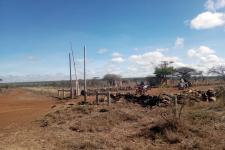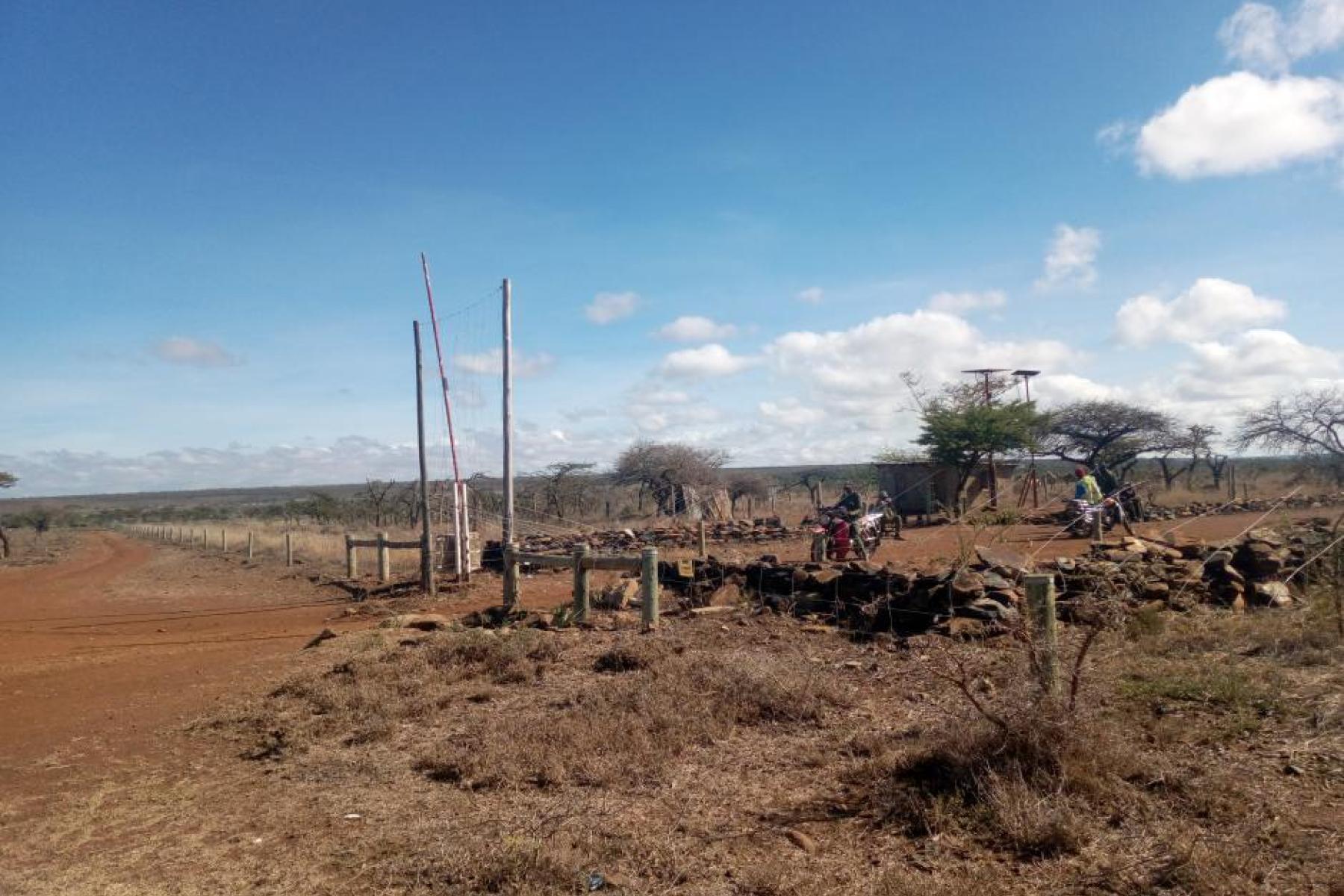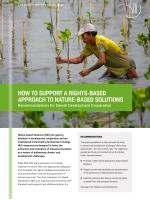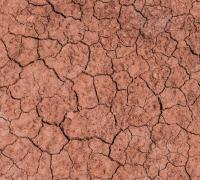Why are fences so provoking?

If you go for a Sunday bike ride out into the Danish landscape, you will likely realise that you cannot simply cross through areas that do not follow the main roads.
Windbreaks, dikes and fences cut through the landscape in various formations. In many places, ploughing goes all the way to the edges. Elsewhere, old roads have been removed, making it challenging to move around freely.
In fact, Denmark is among the world's most divided and demarcated countries, and if you look beyond Denmark's borders, studies show that there are up to 10 times as many fences in the world as there are roads.
We have studied how fences and boundaries come about and tried to find out how it affects humans and animals when markings and boundaries on a map are transformed into physical fences. We did this by looking at two case studies in East Africa, specifically in on the Laikipia Plateau and in the Maasai Mara in Kenya's Rift Valley region.
Fences divide and provide safety
In Denmark, as in large parts of the rest of the world, it has become a routinely and taken-for-granted matter to set up fences and make borders of different kinds.
This means that fences have come to perform many different functions:
- A useful tool that can keep track of what is yours and what is mine. Think of the hedges between houses in a suburban area
- A security provider, as with a fence around a kindergarten
- A practical instrument that retains grazing cows in a certain area, so that you do not have to be present on the field yourself
Fences also play a role in the areas in Denmark that have been designated as “nature national parks”, where they play a part in containing the large animals – wild horses and buffalos – that have been reintroduced.
Fences are also exclusion
But fences are not only erected to protect land, crops, biodiversity, humans and animals. They also often represent stories of exclusion.
This is the case whether you are looking at historic fence installations in America, Australia and Northern Europe, or government projects to build walls on the West Bank, in Jericho or at the Mexican border.
As a consequence, the opposition to the political agendas that drive fencing is often accompanied by attempts to destroy, resist or overthrow the fences themselves.
Because someone will always be excluded when a fence is erected - be it the hedgehog by a garden fence or the landless who loses access to what was once a common area.
In this way, our relationship to fences says a great deal about political history, views of what nature is and, not least, about power relations and privileges.
East Africa on its way towards Danish landscape divisions
The phenomenon of installing and removing boundaries is no less relevant in East Africa. Fences are spreading fast in two of Kenya's largest plains: Laikipia and the Maasai Mara.
There are indications that the areas are heading towards Danish levels of landscape divisions.
In addition to disturbing the movement of wildlife, the fences create conflicts between population groups.
In and around the two areas, fences have spread in a number of contexts, for example with veterinary fences, enclosures of private land and group-owned ranches.
Recently, large electric fences have also been erected around national parks and so-called game reserves.
Imbalance in power and privileges
On the one hand, many of these fences are indeed erected with reference to the practical conditions, such as being able to keep track of domestic animals, protecting wild animals from poachers and keeping them away from farmed lands.
However, the fences are often also embedded in long-term histories, where imbalances in power and privileges have been reinforced through the erected fences.
For instance, this is the case when Masai lose the opportunity to find grazing for their cattle because the grazing areas have been converted to agriculture and have been fenced off. When that happens, one limits the opportunities of others to make use of the resources they would normally rely on.
Interestingly, a closer look at these fences can tell us a great deal about how fenced landscapes arise, including the Danish ones, and about how fencing actually affects us humans and our relationships with each other.
Fencing accelerated in colonial times
In both areas, there are groups who practice pastoralism, that is, they move long distances with their cattle.
But where they make up the majority of the Maasai Mara, the population in Laikipia is more mixed and pastoralism is practiced in between small farmers and large-scale agriculture.
Many may already know the Maasai Mara area from TV nature programs, as the area is well known for its rich wildlife and large annual wildebeest migrations.
In Laikipia, fences slowly began to spread from the 1950s as colonial settlers sought to mark their newly acquired territories and protect their ranches from attacks by wildlife and by pastoralists, including Maasai and Samburu, who remained dependent on the grazing lands.
Then as well as today such situations lead to protests. The big difference today is that both the fences and the protests have escalated in scale - with larger fences and more violent resistance. Conversely, the Maasai Mara has been largely unfenced until just a decade ago.
Currently, fences are spreading to an unpredictable extent; a process partly driven by Mara pastoralists themselves as a way of protecting their right to land from a continued attempt at state intervention.
Why are we fencing?
It was not only the pace and scope of the fencing setup that piqued our interest. It almost invited a study of how historical dynamics enforce a gradual violence across the landscape through those exact processes of erecting, demolishing and re-erecting fences as well as through legislation thereon.
That is, how the relationship between the symbolic and practical boundaries was balanced over a longer time perspective.
We kept asking the question: why do people fence in the Mara when it so blatantly harms wildlife and their own possibilities for practicing pastoralism?
And why do the pastoralists in Laikipia damage the fences when it is obviously not their land that they enclose?
Conflict leads to fencing, which causes conflict
The answers turned out to be found from the bird's eye view of a much longer part of the history than previous research had looked at.
In the early colonial fences in Laikipia as well as in the more elaborate fences of today, fences are both a symbol of the power balance and a material demarcation.
Fence builders need to protect their land with more than just proof of private property.
However, this does not change the fact that the pastoralists need access to grazing for their cattle, and therefore they must continue to break the fences, no matter if this leads to the installation of barbed wire, alarm systems or even a moat.
As one of the pastoralists we have spoken to justifies:
Once, the Danish landscape consisted of uncultivated heath that stretched as far as the eye could see.
Going back to the Bronze Age, most people lived as pastoralists, meaning, they travelled long distances to ensure pasture for their cattle. At that time, people were therefore dependent the ability to move freely with access to the large grasslands and moors.
When the cultivation of the heath took place in the 18th-19th century, the old grazing areas and commons disappeared. Gradually, the agricultural reforms transformed the landscape into a chessboard of subdivisions.
‘There is good grass on the ranch and no grass outside. So what else can we do?”
In the Mara, history has shown the Maasai that an agreement on a piece of paper is not respected. During colonial times, the colonial power repeatedly took over territories that the Maasai had otherwise been promised as theirs, and after Kenya's independence, non-Maasai continued the practice by settling and trying to buy up land.
One of the Maasai says, "No Maasai likes to see the land sold." And when a piece of paper with a signature and a stamp is not protection enough, the Maasai must resort to other means to protect what they have left.
In both cases, we can see how physical fences and boundaries arise in the wake of a historical conflict, and they can therefore be viewed as founded on power imbalances.
Furthermore, we see that people are caught on a path that necessitates escalated fencing - fencing that constitutes a social, an ecological or a political violence against the landscape and its marginalized users. Despite the resistance, this path makes it very difficult to get rid of physical boundaries like fences again once they have been erected.
Therefore, they can be seen as both material and symbolic elements in the landscape, which very clearly communicate power relations by virtue of who creates them and who / what is de facto kept out.
For when it comes to pastoralists, who are often marginalized in connection with the fencing, the physical boundaries have very real implications for their mobile way of life.
Climate change hits harder
At the same time, we know that it is precisely this mobility that makes pastoralists far better equipped to deal with highly changeable landscapes compared to land-based farmers.
East Africa's plains, such as the Mara and Laikipia, are hard hit by climate change, with large temperature increases and greater fluctuations and intensity in this year's weather events.
Here, the rainy season in the future will either be absent or shortened and intensified with the risk of flash floods, and the dry season will more often lead to extreme drought and famine.
The effects will hit pastoralists even harder if the fences make it impossible for them to move from one grazing area to another. The same goes for wildlife.
In this way, our relationship with fencing - our need to fence things in and show what is yours and mine - can have consequences for humans and animals' abilities to adapt to climate change.
That is a matter that concerns us all, whether we are dependent on being mobile or not.
The study is published in the international journal LASND, which publishes articles on environmental change, sustainability and landscape utilization.
DIIS Experts




